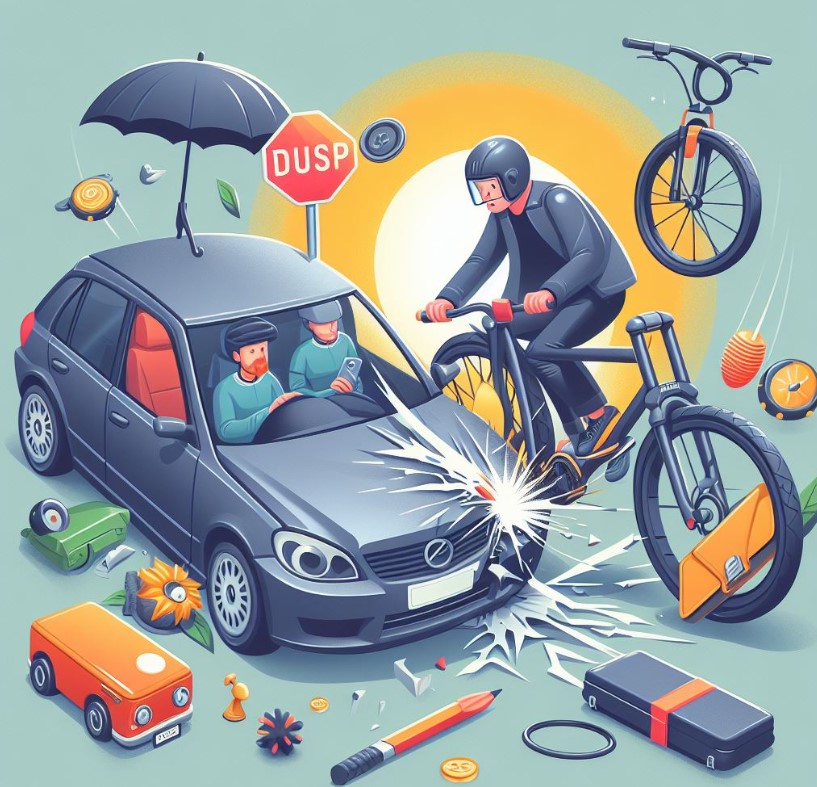What Insurance Covers A Bike Hitting A Car? Explained
When a bicycle hits a car, determining which insurance policy covers the damages and any medical costs is a crucial concern for both parties involved. This question, What Insurance Covers A Bike Hitting A Car? is multifaceted, involving various types of insurance policies and depending on the specifics of the accident, the parties involved, and the laws of the state or country. Understanding the insurance implications is essential for cyclists and drivers alike to navigate the aftermath of an accident effectively.
Key Takeaways
- Liability insurance may cover damages and injuries when a cyclist is at fault.
- The cyclist’s health or auto insurance might provide coverage for their injuries.
- The driver’s auto insurance may offer protection through uninsured motorist coverage or personal injury protection, depending on the policy and location.
What Insurance Covers A Bike Hitting A Car?
When a bicycle collides with a vehicle, and the cyclist is at fault, the cyclist’s homeowner’s or renter’s insurance policy may cover property damage and bodily injuries inflicted on the driver or passengers, under the personal liability section.
However, this is contingent on the specifics of the insurance policy, which can vary widely. It’s also possible for a cyclist’s auto insurance to play a role, especially if they have a policy that covers them as a cyclist.

- Cyclist’s Liability: Homeowner’s or renter’s insurance may cover damages and injuries to others.
- Driver’s Coverage: The driver’s auto insurance may cover their vehicle’s damages under collision coverage.
Cyclist’s Insurance Options
Health Insurance
For the cyclist’s injuries, their health insurance is typically the first line of financial defense. Health insurance can cover medical bills resulting from the accident, regardless of who is at fault. Cyclists need to review their health insurance policy to understand what is covered and whether any deductibles must be met.
Auto Insurance
Surprisingly, a cyclist’s auto insurance might also provide coverage if they are hit by a car, through uninsured or underinsured motorist coverage. This coverage can kick in to cover medical expenses and, in some cases, property damage, depending on the cyclist’s policy and the specifics of the accident.
Driver’s Insurance Coverage
Uninsured Motorist Coverage
If a cyclist hits a car and does not have adequate insurance to cover the damages, the driver’s uninsured motorist coverage may provide compensation for repairs and medical costs. This coverage is specifically designed to protect drivers if the other party is uninsured or underinsured.
Personal Injury Protection (PIP)
In no-fault states, or as an option in others, Personal Injury Protection (PIP) can offer coverage for medical expenses for the driver and passengers, regardless of who is at fault. This can be particularly useful in accidents involving cyclists and vehicles.
State Laws and Insurance Coverage
State laws significantly influence how insurance claims are handled in bicycle-vehicle accidents. In no-fault states, for example, each party’s insurance covers their injuries and damages, up to a certain limit, regardless of who caused the accident. Both cyclists and drivers must be aware of their state’s laws to understand how insurance coverage is applied in these situations.
Comparative and Contributory Negligence
The principles of comparative and contributory negligence also play a vital role in determining insurance payouts. These legal doctrines assess the degree of fault of each party involved in an accident, which can affect the amount of compensation received.
Preventative Measures and Insurance Discounts
Investing in safety equipment and taking cycling safety courses can not only reduce the risk of accidents but may also qualify cyclists for discounts on certain types of insurance. Some insurance companies offer incentives for cyclists who demonstrate a commitment to safety, which can lead to lower premiums.
Safety Equipment
Details on how the use of helmets, reflective gear, and proper lighting can not only enhance safety but also potentially impact insurance rates.
Safety Courses
Information on recognized cycling safety courses and how completion can influence insurance costs, along with data on insurers that offer discounts for such measures.
Reporting an Accident and Filing a Claim
The steps to take immediately following an accident between a bicycle and a car are critical for insurance purposes. This section will detail the importance of reporting the accident to the police and insurance companies, collecting evidence, and the process of filing a claim.
Documentation and Evidence
Advice on gathering witness statements, photographs of the scene, and medical reports to support an insurance claim.
Claim Process
An overview of the typical claim process, including timelines, negotiations with insurance adjusters, and the potential for disputes or denials.
Does Car Insurance Cover Bicycle Accidents?
Car insurance can cover bicycle accidents in several ways, depending on the specifics of the policy and the accident itself. If a driver causes an accident involving a bicycle, the liability coverage of the driver’s car insurance is typically responsible for covering the damages and injuries sustained by the cyclist.

This coverage can help pay for medical expenses, lost wages, and pain and suffering experienced by the bicyclist. Additionally, if the bicyclist has car insurance with uninsured/underinsured motorist coverage, and they are hit by a driver who lacks sufficient insurance, their policy may cover their damages.
However, coverage details and limits can vary widely, so both drivers and cyclists need to understand their policies. In many jurisdictions, car insurance policies are designed to protect victims of vehicular accidents, including cyclists and pedestrians, ensuring they receive compensation for injuries and damages.
Does Car Insurance Cover Hitting A Bicyclist?
Yes, if a driver hits a bicyclist, the driver’s car insurance can provide coverage for the bicyclist’s injuries and damages. This situation typically falls under the driver’s liability insurance, which is designed to cover bodily injury and property damage that the policyholder is legally responsible for causing to others.
Liability coverage will pay for medical costs, potential legal fees, and other damages up to the limits of the policy. The process involves the bicyclist filing a claim against the driver’s insurance policy.
It’s crucial for the driver to report the accident to their insurance company as soon as possible and for the bicyclist to gather and document as much evidence as possible to support their claim, including police reports, medical records, and photographs of the scene and injuries.
Does Bicycle Insurance Cover Damage?
Bicycle insurance can specifically cover damage to the bicycle itself, whether from an accident, theft, vandalism, or other covered events. This type of insurance is distinct from general liability coverage that might be part of a homeowner’s or renter’s insurance policy.
Bicycle insurance policies can offer comprehensive coverage for repairs or replacement of the bike and may even cover accessories and personal belongings depending on the policy.

The scope of coverage, deductibles, and exclusions will vary by insurer and policy, so cyclists should review their insurance details carefully.
Some policies may also offer protection against liability claims if the cyclist is responsible for causing damage or injury to others. Opting for bicycle insurance can provide peace of mind to cyclists, particularly those riding expensive models or using their bicycles frequently.
How Does Insurance Work With Bikes?
Insurance for bicycles works through several avenues, each offering different types of protection:
- Homeowner’s and Renter’s Insurance: These policies often include personal property coverage, which can cover bicycles against theft or damage while at home. However, there may be limitations on coverage amounts, and high-value bikes might require additional riders or endorsements for full protection. Liability coverage included in these policies can cover the cyclist if they are responsible for causing injury or damage to others.
- Specific Bicycle Insurance Policies: Dedicated bicycle insurance policies offer more comprehensive coverage tailored to cyclists’ needs, including damage to the bike, theft (both at home and while out), and liability. These policies can also cover competition and travel, providing broader protection than standard homeowner’s or renter’s insurance.
- Auto Insurance: In the context of accidents involving vehicles, auto insurance can provide coverage for injuries and damages, depending on the policyholder’s coverage and who is at fault. Uninsured/underinsured motorist coverage can be particularly relevant for cyclists.
Cyclists should assess their specific needs, the value of their bicycle, and their risk factors to determine the most suitable type and level of insurance coverage. Consulting with an insurance agent can help identify the best policy options to ensure comprehensive protection while cycling.
Conclusion
Navigating the aftermath of an accident where a bike hits a car involves understanding the complex interplay of various insurance policies and state laws.
Both cyclists and drivers should be proactive in familiarizing themselves with their insurance coverage and the legal framework in their state to ensure they are adequately protected in the event of an accident.
While preventative measures and safety practices can reduce the risk of such incidents, being prepared with the right insurance coverage is indispensable for financial protection and peace of mind.
People Also Ask
What if the driver involved in the accident with a bike flees the scene?
If the driver involved in an accident with a bike flees the scene, it’s considered a hit-and-run. In this case, the cyclist should report the incident to the police immediately and provide as much information as possible about the driver and vehicle. Uninsured Motorist Coverage (UM) on the cyclist’s auto insurance policy, if they have one, may cover injuries and damages in a hit-and-run scenario. Additionally, any personal health insurance will still cover medical expenses.
Are there any special considerations for electric bikes?
Electric bikes (e-bikes) are generally covered under the same principles as traditional bicycles in terms of insurance. However, due to their higher value and motorized nature, some insurers may have specific exclusions or require additional coverage. It’s important to check with your insurance provider to understand how your e-bike is covered, especially under homeowners, renters, or auto insurance policies.
How do I file an insurance claim after a bike accident?
To file an insurance claim after a bike accident, contact your insurance company as soon as possible to report the accident. Provide them with all relevant information, including the accident report, photos of the scene, your injuries, any damages, and witness statements. Follow your insurer’s process for submitting a claim, which may include filling out claim forms and providing additional documentation as requested.
How does fault affect insurance coverage in a bike accident?
Fault plays a significant role in determining which insurance policy applies in the event of a bike accident. In states that follow traditional at-fault rules, the insurance of the party deemed at fault would cover the damages and injuries. In no-fault states, each party’s insurance may cover their injuries regardless of who is at fault, but property damage may still be covered by the at-fault party’s insurance.

Welcome to the exhilarating world of Matt Rex, a professional car racer turned renowned vehicle enthusiast. Immerse yourself in his captivating blog as he shares heart-pounding adventures, expert reviews, and valuable insights on cars, trucks, jets, and more. Fuel your passion for speed and discover the beauty of vehicles through Matt’s engaging stories and meticulous expertise. Join the ever-growing community of enthusiasts who find inspiration and expert advice in Matt Rex’s blog—a digital hub where the thrill of speed meets the pursuit of knowledge.







